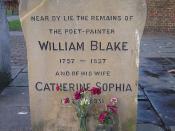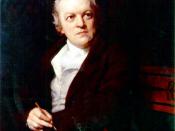It may be easy to read and remember, but it is not easy to understand. Some of Blake's phrases are strange ("immortal hand"), some are archaic ("thine"), and others are used with different meanings from those we use today ("frame"). Added to this, Blake uses many vivid metaphors, which produce strong images of beauty and power ("...burning bright / In the forests of the night") but which are less obvious in their meaning.
The poem is also full of questions - twelve in all. Perhaps Blake intended the poem to be less than easy to understand because he, too, had lots of questions he couldn't answer. The first question hints that this poem is not really about nature despite its title,
"...What immortal hand or eye could frame thy fearful symmetry?"
The "immortal hand" can only refer to God, and this gives the poem a religious theme that is continued through the remaining questions.
Asking so many questions of God - especially the final question, which is a twist on the final line of stanza one, ("What immortal hand or eye / Dare frame thy fearful symmetry?") seems to suggest that Blake cannot understand how God could create an animal that is at one and the same time beautiful and fearful, even evil.
At the end of stanza five, it is easy to imagine the tiger killing the Lamb, and, with the Lamb being given a capital "L" it might refer to the "Lamb of God" or Jesus Christ. Did Blake, who is known to have hated what he saw as God's "natural religion" being misused by the leaders of mankind, mean not a tiger but a man? And that man has somehow destroyed Christ, or at least, what Christ was meant to stand for in the...


